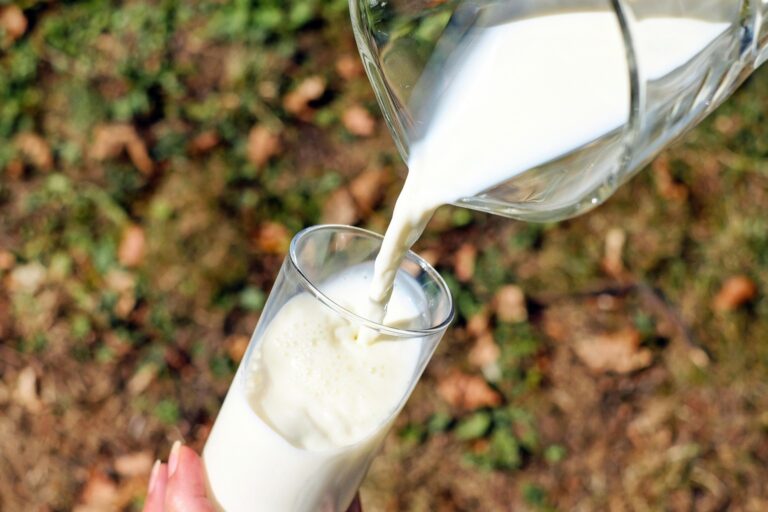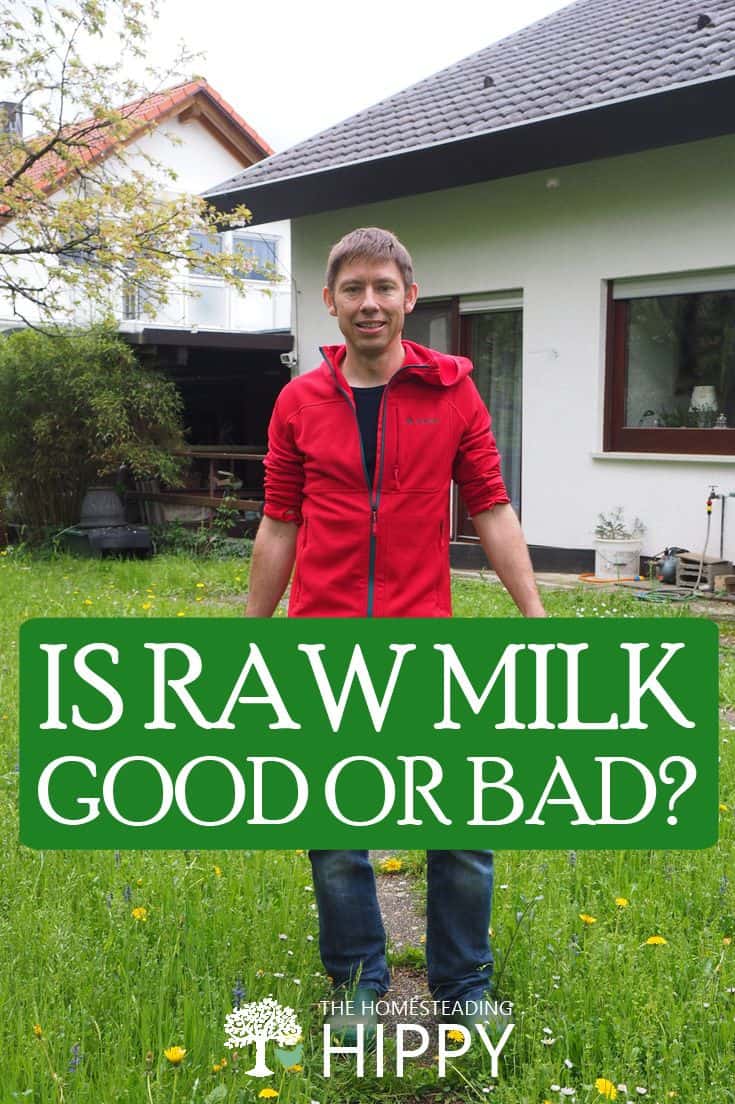There is a growing number of people who are moving over to drinking raw milk in the US – the figure varies between 3.2% to 5% – as they believe it is good for you.
The government does not agree, and while in many states the sale of raw milk is illegal, the government can’t stop you drinking the milk from a cow you own or part own, which is why herd-sharing schemes are becoming popular, as people strive for a healthier lifestyle.
Drinking raw milk may not be good for you and should be avoided as various pathogens pose health risks, and this is why health authorities feel that it is better to drink pasteurized milk.
While raw milk may taste better (and there are some benefits), a person should be properly informed about milk hygiene and the consequences of infection before switching to raw milk.

Before the mid 1900s most milk was consumed raw as it went straight from farm to table without being pasteurised.
But in the early 1900s people were moving to cities and the supply chains were getting longer – milk from the farm had to be transported into town and there was a time delay, allowing pathogens to grow. The result was that many children became ill as a result of unhygienic conditions during milking, storage, and transport.
The spike in cases of scarlet fever, diphtheria, tuberculosis, brucellosis, and Q-Fever prompted the authorities to take action to prevent these often serious diseases described below:
- Scarlet fever – caused by the same type of bacteria that causes strep throat. In scarlet fever, the toxin released by the bacteria causes the rash and scarlet tongue. The strep bacterium can be found in raw milk.
- Diphtheria – Corynebacterium diphtheriae is responsible for this illness that affects either the respiratory system or the skin. 1 in 10 people who contract the form that attacks the respiratory system will die according to the CDC.
- Tuberculosis – spread from cattle, Mycobacterium bovis is usually passed to humans through unpasteurized milk and results in diarrhea and fever. Complications can occur.
- Brucellosis – spread from animals to people through unpasteurized dairy products, its flu-like symptoms include headaches, sweats, fever, back pains, and a sense of physical weakness. If the case is severe, heart lining and the central nervous system can be affected.
- Q-Fever – this bacterium is spread from cattle and also has flu-like symptoms; however it can affect a person’s health and ability to work properly for a number of years.
Along comes Pasteurization
A French biologist, Louis Pasteur, had discovered that heating liquids for a specific period of time did not allow these pathogens to grow and the US took steps to make pasteurization of milk mandatory.
To be certified as pasteurized, milk must be heated to 145° F (63° C) with the heat maintained at that temperature for 30 minutes.
New systems have come in that pasteurize the milk to higher temperatures for shorter periods of time, improving the length of time the milk can be refrigerated.
For example, if milk is heated to 162° F (72° C) and the heat maintained for 15 seconds it will kill the pathogens, yeasts and molds that could cause problems.
Heated to even higher temperatures for just a few seconds will produce the same effect.
The Position of Health Authorities
The position of the U.S. government and health experts around the world is that milk should not be consumed raw, as it can carry various pathogens such as E-Coli, salmonella, listeria, Brucella, Mastitis, Campylobacter, and Cryptosporidium, among others.
If the necessary precautions are not taken, infected milk can pose health risks to you and your family.
The FDA has put out this notice on the dangers of consuming raw milk. And the Centre for Disease Control weighs in with this artic
le citing how drinking raw milk contaminated with bacteria can result in diarrhea, stomach cramping and vomiting.
The CDC maintains in the article that drinking raw milk may result, as they put it, ‘less commonly’ in conditions that include Guillain-Barré Syndrome that could cause paralysis and they mention haemolytic uremic syndrome (when small blood vessels within the kidney become blocked or inflamed) that could result in kidney failure, stroke and possibly even death.
These are quite scary and one would not want to take a chance however, those most at risk are considered to be:
- Infants and children under 5 years of age
- Pregnant women – listeria can cause miscarriage, or illness and even death for the baby.
- People aged 65 and older
- People with compromised immune systems, because of cancer or cancer treatments, HIV, organ transplants, or various other diseases
Raw Milk Movement
While raw milk sales are prohibited in 20 states, it is not illegal to drink raw milk in any US state. The government can’t stop you from drinking the milk from a cow you own or part own, which is why herd-sharing schemes are becoming popular.
Proponents of the raw milk movement, particularly in the US, want to go back to nature, away from the government-imposed legislation that insists all milk be pasteurised, citing a number of reasons to support their viewpoint.
This is what the proponents claim:
- Raw milk helps control blood pressure, as it has sufficient Vitamin D and calcium and the protein content helps with the absorption of minerals
- Raw milk is full of gut-healthy bacteria and as such is a good pro-biotic drink.
- Raw milk has soluble vitamins that include A, K and E in the fat content of the milk
- We all know milk has calcium to build strong healthy bones and teeth, but proponents of the raw milk movement say pasteurized milk has less. The calcium from raw milk is absorbed by the body easily.
- Raw milk works as a skin toner and moisturizer because it has all the vitamins like B12 still in it.
- Children raised on raw milk seem less susceptible to asthma and food allergies
- There are claims that raw milk helps children with autism, but to date there doesn’t seem to be conclusive proof.
This study of the health benefits of raw versus pasteurized milk came to the conclusion that the benefits claimed for raw milk over pasteurized milk could not be backed by sufficient scientific evidence, and that the risk to benefit ratio was disproportionate.
Basically, stick to drinking pasteurized milk, is the conclusion drawn by health experts and scientists.
Does Raw Milk Taste Better Than Pasteurized Milk?
It depends what you are used to. I grew up drinking only raw milk from a kid until the age of 16 when the law changed and pasteurization was forced on everyone. The dairy that had supplied us with milk, unable to cope with the costs of the changes, shut down.
My first taste of pasteurized milk was so awful I spat it out and never drank a glass of milk again. It’s ok for putting on cereal though. On the other hand someone used to pasteurized milk may not like the taste of raw milk with its thicker creamier taste.
Incidentally I have never suffered from high blood pressure, have no food allergies, have exceptionally strong teeth and have never broken a bone – that may be just genes, or luck, or maybe all the raw milk – who knows? I also do not get flu or colds easily – maybe once in 5 years or so and then quite lightly. Again, who knows?
Still Want to Drink Raw Milk? Then Keep These in Mind…
Tip #1. Preferably drink the milk from your own cow that is grass fed, with no additional hormones or questionable food.
Tip #2. Make sure the animal is well brushed so no loose dirt of hair falls into the milk if you are using a pail. You definitely don’t want any faecal matter getting in there, either – that’s where the E. coli comes in – so the tail and back legs of the animal should be secured.
Tip #3. If a milking machine is used hygiene and sanitization of the equipment is very important, and if milking by hand, sanitization of hands and equipment is important.
Tip #4. Use running water and use your sanitized hands to wash the teats and udder, not a cloth, as this is unhygienic and can spread mastitis.
Mastitis is caused by the bacteria Staph aureus and / or Strep agalactiae that get into the teat canal and move into the udder. When you have a number of dairy cows a lack of handwashing between hand milking or unsanitary milking machinery can spread the infection.
Just a splash of milk or some residue of milk from one cow with mastitis left on the teat cup of milking machinery can spread the disease.
In severe cases, there may be blood in the milk. If caught early, mastitis can be treated, if left too long the animal may need to be culled.
Unfortunately, big commercial dairies may have one cow with mastitis and some of the pus could get into the milk – pasteurization is therefore absolutely necessary because of the number of cows kept on big dairy farms. Checks are made on bulk milk tanks by authorities for various pathogens.
Tip #5. The first milk should be tested because subclinical infection means milk appears normal. Agricultural extension officers will be able to help with a mastitis test to detect an elevated somatic cell count, or you can use the California Mastitis Test (CMT).
If a teat is squeezed and a cottage-cheese-like thing comes out, then the cow is infected. Similarly, thin milk or blood in the milk can indicate infection. This extremely painful condition should be treated immediately to avoid distress for the animal.
Tip #6. Use a milking salve, and not a bit of milk, to start the process of milking. Using milk can spread infection.
Tip #7. Make sure if hand milking that the milk from the pail goes into a container that has a gauze or muslin cover so the milk is strained through it and no foreign matter gets into the milk.
Tip #8. Keep milk covered and cool to prevent bacterial growth.
Claims Made for Raw Milk
Raw milk proponents believe that consuming raw milk will provide you with vitamin A, K and E, that raw milk is rich in water soluble vitamins such as C and B which are destroyed when exposed to heat.
However, studies have indicated that calcium absorption is unchanged with pasteurization and that vitamin A, and D, are not affected by heat.
Raw milk proponents are correct in the claims about vitamin B as there is approximately a 10% loss of Vitamin B12 during the process of pasteurization as well as a loss of thiamine (Vitamin B1). Now according to this study carbohydrate metabolism involves thiamine as a co-factor required by enzymes in two pathways.
A reduction in thiamine needed as building blocks for proteins and DNA as well as brain chemicals can result in serious brain disorders.
Riboflavin and niacin it seems are not affected. Scientific studies have concluded that pasteurization does not significantly alter the nutritional qualities of milk or its important nutrients other than Vitamin B12, and thiamine.
Outbreaks Related to Raw Milk
Outbreaks reported to CDC are just the tip – there are so many that go unreported. Only when mass hospitalizations occur do people start taking notice.
While it is good to think about going as natural as possible don’t mess with the health of your children – it’s a risk not worth taking, as many of the outbreaks reported do involve children between 1 and 4 years with salmonella or E. coli. You don’t want to risk kidney failure or even death for a child.
So to answer the question, “Is raw milk good for you?” – it may not hurt you, but why take the risk?


As a child I wanted to grow up and marry a farmer… simply because it was so different from my life right on the shores of the ocean. Well, I didn’t marry a farmer but a surfer instead. The urge, however, to grow stuff and make great food for a big family never left. We are on acreage with a sea view and easy access to fresh caught crayfish and other seafood – the best of both worlds. As an artist and writer I enjoy creating new recipes, tweaking traditional ones, and sharing the results not only with family and friends, but online. Mee the rest of the team at this page.
